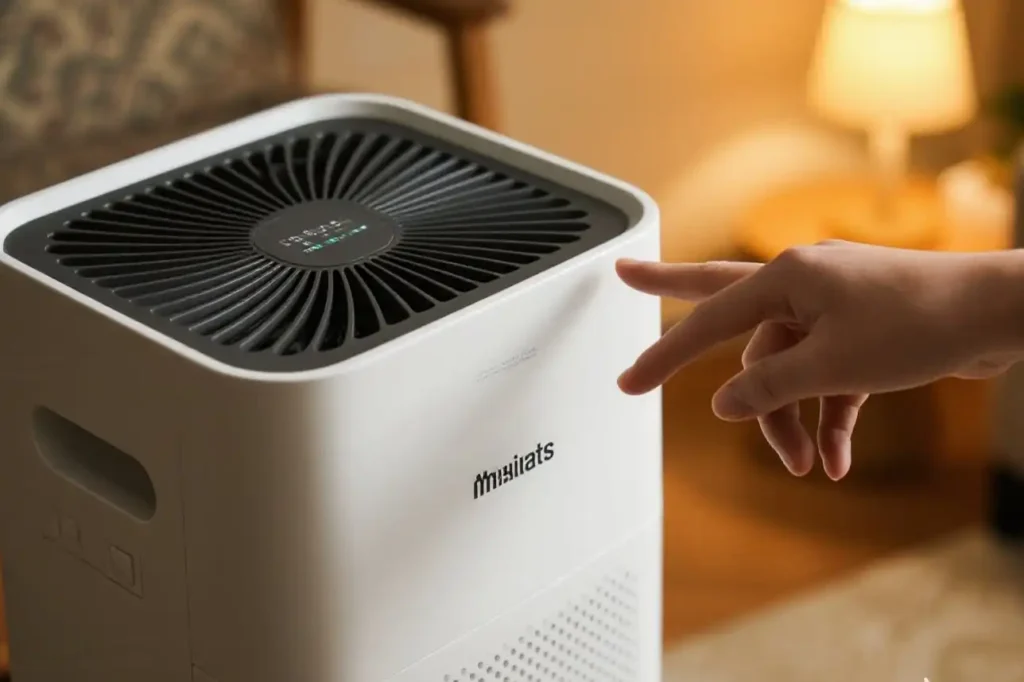
You can use an air purifier to help lower some breathing problems at home. This device pulls air through filters. It removes dust, pollen, mold spores, and some bacteria and viruses. Many people with allergies or asthma feel better with cleaner air.
- Studies show that air purifiers with HEPA filters can cut indoor particles by up to 50%. This may help people with asthma breathe a little better.
- The Asthma and Allergy Foundation of America says to pick certified filters. These filters trap almost 98% of allergen particles.
More people want air purifiers because they care more about health and new technology is available.
Key Takeaways
- Air purifiers with HEPA filters take out most dust, pollen, mold, and some germs. This helps people with allergies and asthma breathe better.
- Air purifiers with both HEPA and activated carbon filters clean out particles and bad gases. This makes the air inside your home better.
- Pick an air purifier that matches your room size. Check the Clean Air Delivery Rate (CADR) to make sure it cleans the air well.
- Change and clean the filters often to keep your air purifier working right. This helps keep the air in your home healthy.
- Air purifiers lower the number of germs in the air. They work best when you also have good airflow, clean often, and follow other healthy habits.
How Air Purifiers Work

HEPA Filters
Most air purifiers use HEPA filters as their main part. HEPA means High-Efficiency Particulate Air. These filters catch 99.97% of tiny particles, even ones as small as 0.3 microns. The fibers inside a HEPA filter trap particles in four ways:
- Big particles hit the fibers and get stuck.
- Medium particles move with the air and stick to the fibers.
- Very small particles move in random ways and hit the fibers.
- Some fibers have a charge that pulls in particles.
HEPA filters take out dust, pollen, pet dander, mold spores, and some bacteria and viruses. You get cleaner air because these filters grab harmful particles.
Other Technologies
Some air purifiers use more than just HEPA filters. You might see activated carbon filters, UV light, or electrostatic filters in some models.
- Activated carbon filters have tiny holes that trap gases, smells, and VOCs. These filters are good for smoke, cooking smells, and chemicals from cleaners.
- UV light can kill or stop bacteria, viruses, and mold spores.
- Electrostatic filters use an electric charge to pull in and trap particles.
Many air purifiers mix these technologies to remove both particles and gases. This mix gives you better protection from many indoor pollutants.
| Filter Type | Particle Removal Efficiency | Notes |
|---|---|---|
| HEPA | 99.97% (≥0.3 microns) | Best for most homes, balances airflow & cost |
| ULPA | Up to 99.999% | Higher efficiency, but less airflow |
| Electrostatic | Around 97% | Needs regular cleaning |
Pollutants Removed
You want an air purifier that removes the pollutants in your home. The main pollutants removed are:
- Dust and dust mites
- Pollen
- Pet dander
- Mold spores
- Bacteria and viruses
- Smoke particles
- VOCs and smells from paint, cleaners, and cooking
Tip: Using an air purifier with both HEPA and activated carbon filters helps you remove both particles and gases from your indoor air.
Studies show that using an air purifier can quickly lower dust, pollen, and pet dander. This helps you breathe better, especially if you have allergies or asthma. By catching airborne particles and droplets, air purifiers lower your contact with harmful things and germs.
Air Purifier Benefits

Allergy and Asthma Relief
You might have fewer allergy and asthma problems with an air purifier. These devices catch dust, pollen, pet dander, and other things that cause allergies. Breathing in less of these makes your nose and lungs feel better. Many studies show HEPA filters help people with allergies and asthma. Some research found people had better asthma scores and used less allergy medicine after using an air purifier. In one study, kids with asthma felt better when their rooms had air cleaners and other ways to control allergens. Adults with dust mite allergies also needed less medicine when they used a HEPA filter at home. If you use your air purifier every day, you can expect cleaner air and fewer things that trigger allergies.
Note: For the best results, use an air purifier along with other steps like washing bedding and vacuuming to help with allergy and asthma relief.
Reducing Airborne Illness
Air purifiers can help lower germs and viruses in the air. HEPA filters catch tiny particles, including some that carry viruses like the flu or COVID-19. Using an air purifier means you breathe in less dust and droplets that can spread sickness. Here are some findings about air purifiers and illness:
- Medium to high-efficiency filters (like MERV 13–16) in HVAC systems can trap infectious aerosols and lower the risk of infection.
- Mobile air purifiers with HEPA filters can cut down airborne particles by 45% to 90%. This means there are fewer virus carriers in the air.
- In classrooms, HEPA air purifiers lowered the amount of virus a person could breathe in by six times during two hours.
- Some commercial air purifiers showed up to 90% less large particles and 80% less small ones in homes.
Even though these results look good, scientists still talk about how much air purifiers really lower the spread of sickness like COVID-19 or the flu. You should always use other safety steps, like washing your hands and keeping rooms aired out, along with your air purifier.
Respiratory Health Support
You may want to use an air purifier to help your lungs stay healthy. These devices take out fine particles, smoke, and chemicals from the air. Cleaner air can help you breathe easier, especially if you have asthma or allergies. Some research shows air purifiers can lower indoor air pollution by about half or more. This drop in pollution may mean fewer asthma symptoms and better breathing for people with lung problems. The Environmental Protection Agency (EPA) says air purifiers can help with allergy and asthma symptoms for a short time.
- Some studies found small improvements in breathing and heart health for older adults and people with lung conditions.
- Other research did not find big changes in healthy people after using air purifiers for a short time.
- Most experts agree air purifiers work best when you use them with other healthy habits, like cleaning and keeping windows closed on days with lots of pollution.
Tip: Put your air purifier in the room where you spend the most time, like your bedroom or living room, to get the most help.
Limitations
What Air Purifiers Can’t Do
Air purifiers help clean the air, but they cannot do everything. You should know what these machines cannot fix:
- Air purifiers do not remove every gas. Gas filters only work for some chemicals and get weaker over time.
- Big things like heavy dust or pet fur fall to the ground before the filter can catch them. Air purifiers miss these large particles.
- Some types, like ionizers and ozone generators, can make ozone. Ozone can hurt your lungs and make asthma worse. Breathing ozone may cause coughing, chest pain, or even lung damage that does not go away.
- UV light and photocatalytic cleaners do not kill every germ or remove all gases. Sometimes, they can even make new things that bother your lungs.
- Small air purifiers may not clean big rooms well. Many are not strong enough to get rid of big allergens like pollen or dust mites in a whole room.
- Filters can get dirty or moldy if you do not change them often. Dirty filters might send germs or mold back into your air.
Note: Air purifiers do not stop mold or bacteria from growing on their filters. Some new filters say they can do this, but most cannot.
Remember, air purifiers do not take the place of cleaning. You still need to dust, vacuum, and wash things to keep your home healthy.
Importance of Ventilation
Ventilation means letting fresh air come in and old air go out. This helps lower indoor pollution by mixing in outdoor air. Air purifiers and ventilation work best when used together. Ventilation gets rid of things that air purifiers cannot, like some gases or big particles.
| Method | What It Does | Best Use Case |
|---|---|---|
| Ventilation | Brings in fresh air, removes stale air | Everyday air exchange, lowers CO2 |
| Air Purifier | Filters out particles and some gases | Targeted removal of allergens, smoke |
Health experts say ventilation is the best way to keep indoor air clean. Air purifiers are helpful, especially if you cannot open windows or if outside air is bad. You should not only use air purifiers to protect against viruses like COVID-19. Cleaning, good ventilation, and changing filters all help keep your air healthy.
Choosing an Air Purifier
Filter Types
You want to pick the right filter for your needs. HEPA filters remove at least 99.97% of tiny particles like dust, pollen, and mold spores. Activated carbon filters trap odors, gases, and smoke. Some air purifiers use UV light to kill germs and viruses. Each filter type works best for certain problems. The table below shows how each filter works and what you need to do to keep it working well:
| Filter Type | What It Removes | Maintenance Needed |
|---|---|---|
| HEPA | Dust, pollen, mold, pet dander, some bacteria | Replace every 6–12 months |
| Activated Carbon | Odors, gases, smoke, VOCs | Replace every 3–6 months |
| UV Light | Bacteria, viruses, mold spores | Clean bulb and parts regularly |
Tip: For the best results, choose an air purifier with both HEPA and carbon filters.
Room Size
You need to match the air purifier to your room size. A small purifier cannot clean a big room well. Look for the Clean Air Delivery Rate (CADR) on the box or in the manual. The CADR should be at least two-thirds of your room’s square footage. For example, if your room is 150 square feet, pick a purifier with a CADR of at least 100. Experts also suggest getting a model that can change the air in your room about five times every hour. This keeps the air fresh and clean.
- Measure your room’s length and width to find the size.
- Check the CADR and Air Changes per Hour (ACH) on the label.
- Pick a quiet model if you want to use it in a bedroom.
Certifications
Certifications help you know if an air purifier is safe and works well. Look for these labels:
| Certification | What It Means |
|---|---|
| AHAM | Shows the purifier’s CADR and tested results |
| CARB | Proves low ozone emissions |
| Energy Star | Uses less energy and saves money |
| UL | Meets safety standards |
Note: Avoid air purifiers that make ozone. Ozone can harm your lungs.
Maintenance Tips
You need to take care of your air purifier to keep it working. Change HEPA filters every 6–12 months. Replace carbon filters every 3–6 months. Clean pre-filters every 1–3 months. Wipe the outside with a damp cloth every few weeks. Check for filter change lights or signs like bad smells or less airflow. Place your purifier in an open spot, away from walls and furniture, for the best airflow.
- Change filters on time.
- Clean the unit and vents often.
- Watch for warning lights or strange noises.
- Keep the purifier in the room you use most.
Keeping up with maintenance helps your air purifier last longer and keeps your air clean.
Air purifiers help remove dust, pollen, and bad gases at home. Research shows they can help your lungs work better. They also lower asthma attacks, mostly for kids and people with allergies. You get the most help if you also clean and let in fresh air.
Remember: Change filters when needed and choose the right size for your room. Clean air makes it easier to breathe and keeps you healthy.
FAQ
What does a HEPA filter remove from the air?
A HEPA filter removes dust, pollen, pet dander, mold spores, and some bacteria and viruses. You get cleaner air because the filter traps tiny particles that can cause breathing problems.
What size room works best for an air purifier?
You should match the air purifier to your room size. Check the Clean Air Delivery Rate (CADR) on the label. A higher CADR means the purifier works better in bigger rooms.
What maintenance does an air purifier need?
You need to change filters on time. HEPA filters last 6–12 months. Carbon filters last 3–6 months. Clean the outside and vents often. Watch for filter change lights or strange smells.
What are the main benefits of using an air purifier?
You get fewer allergy and asthma symptoms. Air purifiers lower dust, pollen, and germs in your home. You may breathe easier and feel healthier, especially if you have lung problems.
What should you avoid when choosing an air purifier?
Avoid air purifiers that make ozone. Ozone can hurt your lungs and make asthma worse. Always check for safety certifications like CARB or AHAM before you buy.
See also
7 Surprising Health Benefits of Using an Air Purifier
Air Purifiers Explained: Function, Benefits, and Myths
